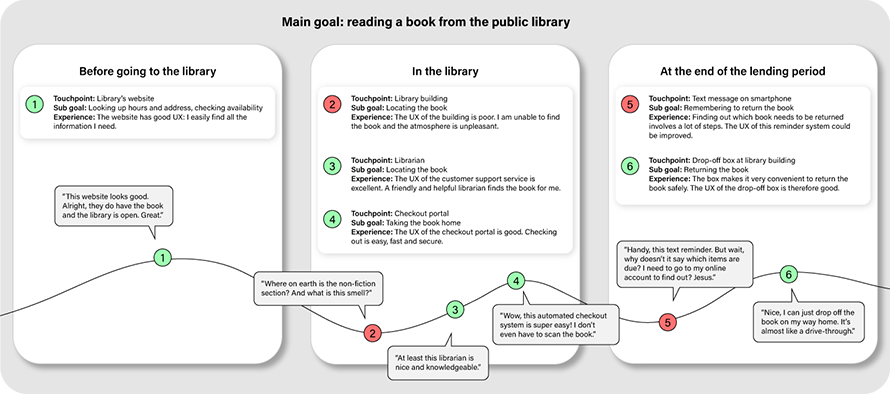Over the past years concepts like Customer Experience Design (CX) and User Experience Design (UX) have become increasingly relevant. Oftentimes CX design and UX design are used as interchangeable concepts, which can be confusing and lead to misunderstandings. So what are we talking about when we are talking about UX and CX? Are the two concepts worlds apart or are UX and CX more like synonyms? Tomato tomato? Let’s clarify!
Jody Torfs - January 2020

What is User Experience Design?
User Experience Design is designing services or digital or physical products in a way that makes them successfully fulfill and satisfy the needs of the user. When the UX Design of a product is good, interacting with the product is easy, pleasant and fulfilling the right needs in the right way. When the UX Design of a product is bad, interacting with the product leads to frustration and ultimately to ceasing to use the product (and maybe even abandoning the company offering the product).
What is Customer Experience Design?
Customer Experience Design is designing every touchpoint in a customer or user journey to be successfully fulfilling and satisfying the needs of the user. A touchpoint is any interaction of the user with the company or organisation. The use of a singular product such as a website can be a touchpoint, calling the helpdesk can be another touchpoint. The touchpoints are the steps of the customer journey. When the customer journey is easy, pleasant and each step of it is fulfilling the user’s needs, the CX Design is good.
A public library as example
Let’s make UX and CX a little bit more tangible with an example: a public library. As an avid reader, I frequently use the services of a public library. My end goal is pretty simple: I want to read a book. I go to the library to fulfill my need. In doing so, there are multiple moments I interact with the library. Any interaction I have with the library or the library system is a touchpoint, all touchpoints together are my customer journey.

1. Before going to the library
- Touchpoint: the library’s website. I surf to the library’s website to look up the address, hours and availability of the book. The user experience of the website is pretty good: the website is easy to navigate, is aesthetically pleasing and I find the information I need in no time.
2. In the library
- Touchpoint: the library building. I’m interacting with the atmosphere, interior architecture and signage in the building. I try to locate the book, which seems harder than expected. I’m looking for the fiction section, but I can only see signs that lead to numerical category sections which I don’t understand. Also, there is a weird smell and I can’t find the elevators. The UX of the library building is not great.
- Touchpoint: librarian. I resort to asking a librarian where I can find the book. The friendly librarian helps me find the book and even explains to me the numerical category system. The UX of the customer support service is excellent.
- Touchpoint: checkout portal. I end up getting multiple books. I check out all of them via an automatic checkout portal, which is fast and easy. The UX of the checkout portal is good.
3. After reading the book or at the end of the lending period
- Touchpoint: my smartphone. I receive a message that reminds me that some of my items are due. The message doesn’t say which items are due. I am not sure which items to return since I got other library books from different times as well. The text message has a link to the “My Account” page on the website. I need to login and click a level deeper to find out which items are due. The UX of the text message reminder system could be improved.
- Touchpoint: drop-off box outside of library building. I don’t need to go in and check out my book, which is very convenient. The UX of the drop-off box is good.
To summarize: while the overall customer experience of the library is acceptable, there are multiple opportunities to improve the user experience of certain touchpoints – and thus improve the customer experience as a whole.
So how do UX and CX relate?
The customer experience considers the experience of a person during all interactions with a company or organisation. The user experience considers the experience during one of these interactions. The concept customer experience can also simply be understood as the user experience of all the products, processes and services as a whole. The two concepts will be mixed up since they are essentially talking about the same thing. Usually the context makes it clear what is being referred to: the user experience of a single thing or of multiple things. It comes down to semantics.



